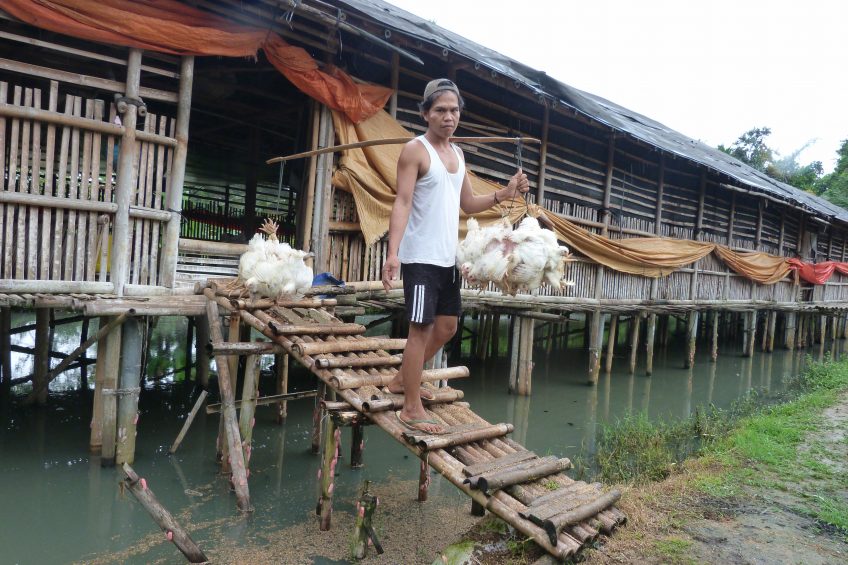Investment in broiler houses in West Java: Makes good sense

Wageningen Economic Research Institute did a case study into the economics of closed versus open broiler houses in West Java. Better production performance leads to 11% lower production costs per kg final live weight, resulting in a payback period of the whole investment in a closed house of 4.5 years or less.
The traditional open house is based on a simple broiler house with a high roof, natural ventilation, manual feeding/water, open side walls and a slatted floor. The closed house has two floors with a low ceiling, mechanical tunnel ventilation, automatic feeding/water, (semi) closed side walls (with plastic curtains) and closed floors with litter.
Basic production performance data were measured at two broiler farms in West Java (Table 1). Both farms had a traditional house and a closed house for broilers. The closed houses were built in 2016. Production performance data of the open and closed houses were collected and analysed by Mr van Emous (DIFS-Live annual report 2016). On both farms, the broilers had a similar growing period in both systems. However, in the closed housing system on both farms the final live weight was higher, and feed conversion and mortality lower. Mr van Emous concluded that production results differ between the housing systems for these farms.
Investments
For the economic evaluation, calculations were made for the investment on a farm with only open housing and on a farm with only closed housing. We assume that on both farms 40.320 broilers are kept. On the farm with open housing, these broilers are kept in seven houses of eight meter wide and 80 meter long. The total ground surface area of the open house is 4.480 m2. The average density is nine broilers per m2 poultry house. The empty period is 28 days. On the farm with closed housing, the broilers are housed on 2 levels in a house of 12 meter wide and 105 meter long. The total ground surface area of the house is 1260 m2. The total surface available for the broilers is 2.520 m2, because they are kept on 2 levels. The average density is 16 broilers per m2 living area. The empty period is 28 days.
Table 2 gives the investment in the poultry houses and equipment for a farm with the open and a farm with the closed housing system. The total investment on a farm with closed housing is almost nine times higher than that on a farm with open housing. With closed housing, higher investments per m2 are needed for the electricity installation (mechanical ventilation and automatic feeding). Furthermore, the investment for equipment per m2 with closed housing is higher as a result of the higher density and a higher level of automatisation. Finally, with closed housing an extra investment is needed in a generator as a backup for a situation with a electricity power cut.
Also read: West Java: Ventilation in the poultry house makes a world of difference
Production costs
Production costs were calculated for the farms with an open and closed broiler house assuming a price of 4,500 IDR (€0.30) per day-old chick and a feed price of 7,000 IDR (€0.47) per kg. For the open housing, the depreciation period was ten years for the house and eight years for the equipment. For the closed housing, the depreciation period was 15 years for the house and 8 years for the equipment. The total production costs per broiler houses were almost equal in both housing systems (Table 3).
For closed housing, the variable costs for feed and electricity were higher and variable costs for heating and animal health lower. Fixed costs for housing and equipment were clearly higher for closed housing. This was partly compensated by lower labour costs for the closed housing.
Although the total production costs in the two systems are quite similar per bird, the production costs per kg broiler meat produced per broiler housed are different. This is because the technical production data differs between the two systems. The amount of meat per broiler housed produced in the closed house system is higher than in the open housing system, because of a higher final live weight and a lower mortality. For the open housing, the total production per broiler housed is 1.41kg and this results in production costs of 17,190 IDR (€ 1.12) per kg final live weight. For the closed housing, the total production per broiler housed is 1.61 kg and this results in production costs of 15,276 IDR (€ 0.99) per kg final live weight. Production costs per kg final live weight are thus about 11% lower on a farm with a closed housing system compared to a farm with an open housing system. The payback period is calculated taking the total investment for the closed house divided by the annual cash flow. To estimate annual cash flow, a farm gate price of 16,000 IDR (€ 1.04) per kg live weight was used. For the basic situation the payback period is 4,5 years (Table 4).
Sensitivity analysis
Many factors influence the payback period, of which the most important are the production results, revenue prices, and costs of feed and day-old chick. Table 4 also provides an overview of the impact of changes in these factors. When production performance in the closed housing was above average (production performance of farm A), the payback period was reduced to 3.6 years. At lower than average production results (farm B), the payback period was longer: 6.1 years. Slightly lower revenue prices (from 16.000 to 15.750 IDR (€1.04 – €1.02) per kg live weight) resulted in a longer payback period of 6.0 years. A lower feed price resulted in a shorter payback period, whereas a higher price of day-old chicks in a longer payback period. It can be concluded that good production results are an important condition for a short payback period and the payback period is highly dependent on input and output prices.













